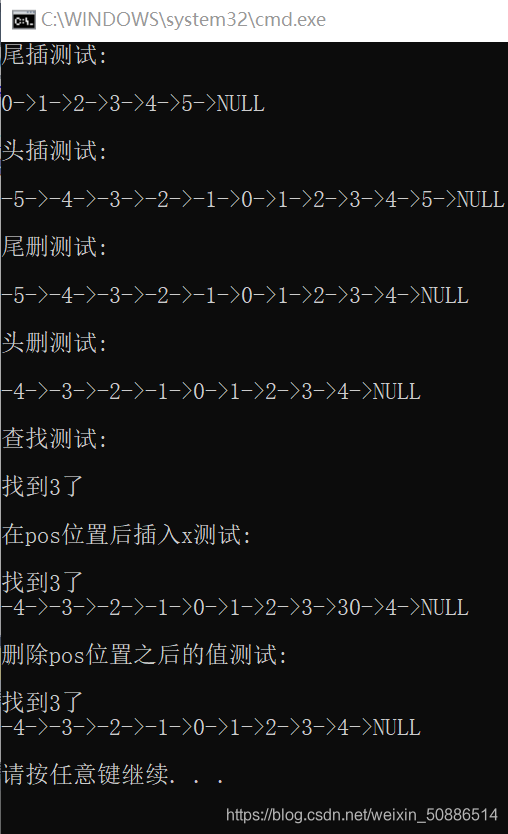目录:
1.什么是链表
链表:是一种物理存储结构上非连续,非顺序的存储结构,数据元素的逻辑顺序是通过链表中的指针链接次序实现的

实际中链表的结构非常多样,有以下情况组合起来的8种链表结构
a.单向,双向
b.带头,不带头
c.循环,不循环
如上图所示就是一个单链表的逻辑结构
2.增删查改功能图解
a.尾插

b.头插

c.尾删

e.头删

f.在pos位置之后插入x

g.删除pos位置之后的值

3.单链表的实现
(1)SingleList.h 单链表各项功能的接口及函数的声明
#pragma once
#include<stdio.h>
#include<stdlib.h>
typedef int SLTDataType;
typedef struct SListNode
{
//数据
int data;
//指针指向下一个节点
struct SListNode* next;
}SListNode;
//打印链表
void SListPrintf(SListNode* phead);
//动态申请一个节点
SListNode* BuySListNode(SLTDataType x);
//尾插
void SListPushBack(SListNode** pphead, SLTDataType x);
//头插
void SListPushFront(SListNode** pphead, SLTDataType x);
//尾删
void SListPopBack(SListNode** pphead);
//头删
void SListPopFront(SListNode** pphead);
//查找
SListNode* SListFind(SListNode* phead, SLTDataType x);
//在pos位置之后插入x
void SListInsertAfert(SListNode* pos, SLTDataType x);
//删除pos位置之后的值
void SListEraseAfert(SListNode* pos);
(2)SingleList.c 各个接口功能的实现
#include"SingleList.h"
//打印链表
void SListPrintf(SListNode* phead)
{
SListNode* cur = phead;
while (cur != NULL)
{
printf("%d->", cur->data);
cur = cur->next;
}
printf("NULL\n");
}
//动态申请一个节点
SListNode* BuySListNode(SLTDataType x)
{
SListNode* newnode = (SListNode*)malloc(sizeof(SListNode));
if (newnode == NULL)
{
printf("malloc node fail!\n");
exit(-1);
}
newnode->data = x;
newnode->next = NULL;
return newnode;
}
//尾插
void SListPushBack(SListNode** pphead, SLTDataType x)
{
SListNode* newnode = BuySListNode(x);
//phead为空直接把newnode给phead
if (*pphead == NULL)
{
*pphead = newnode;
}
else
{
SListNode* tail = *pphead;
while (tail->next != NULL)
{
tail = tail->next;
}
tail->next = newnode;
}
}
//头插
void SListPushFront(SListNode** pphead, SLTDataType x)
{
//开一个新的节点
SListNode* newnode = BuySListNode(x);
if (*pphead == NULL)
{
*pphead = newnode;
}
else
{
SListNode* cur = *pphead;
*pphead = newnode;
newnode->next = cur;
}
}
//尾删
void SListPopBack(SListNode** pphead)
{
//防止空链表再删
if (*pphead == NULL)
{
return;
}
//链表只有一个节点,防止空指针
else if ((*pphead)->next == NULL)
{
//free的是这段空间,指针还在
free(*pphead);
*pphead = NULL;
}
else
{
SListNode* tail = *pphead;
while (tail->next->next != NULL)
{
tail = tail->next;
}
free(tail->next);
tail->next = NULL;
}
}
//头删
void SListPopFront(SListNode** pphead)
{
//防止空链表再删
if (*pphead == NULL)
{
return;
}
//链表只有一个节点,防止空指针
else if ((*pphead)->next == NULL)
{
free(*pphead);
*pphead = NULL;
}
else
{
//保存pphead下一个节点的位置
SListNode* cur = (*pphead)->next;
free(*pphead);
*pphead = cur;
}
}
//查找
SListNode* SListFind(SListNode* phead, SLTDataType x)
{
SListNode* cur = phead;
while (cur != NULL)
{
if (cur->data == x)
{
printf("找到%d了\n", x);
return cur;
}
else
{
cur = cur->next;
}
}
printf("没找到%d\n", x);
return NULL;
}
//在pos位置之后插入x
void SListInsertAfert(SListNode* pos, SLTDataType x)
{
//开一个新的节点
SListNode* newnode = BuySListNode(x);
SListNode* posnext = pos->next;
pos->next = newnode;
newnode->next = posnext;
}
//删除pos位置之后的值
void SListEraseAfert(SListNode* pos)
{
if (pos->next == NULL)
{
return;
}
else
{
SListNode* posnextnext = pos->next->next;
free(pos->next);
pos->next = NULL;
pos->next = posnextnext;
}
}
(3)test.c 用于测试各项功能
#include"SingleList.h"
int main()
{
SListNode* phead = NULL;//空链表
//尾插
printf("尾插测试:\n\n");
SListPushBack(&phead, 0);
SListPushBack(&phead, 1);
SListPushBack(&phead, 2);
SListPushBack(&phead, 3);
SListPushBack(&phead, 4);
SListPushBack(&phead, 5);
SListPrintf(phead);
printf("\n");
//头插
printf("头插测试:\n\n");
SListPushFront(&phead, -1);
SListPushFront(&phead, -2);
SListPushFront(&phead, -3);
SListPushFront(&phead, -4);
SListPushFront(&phead, -5);
SListPrintf(phead);
printf("\n");
//尾删
printf("尾删测试:\n\n");
SListPopBack(&phead);
SListPrintf(phead);
printf("\n");
//头删
printf("头删测试:\n\n");
SListPopFront(&phead);
SListPrintf(phead);
printf("\n");
//查找
printf("查找测试:\n\n");
SListFind(phead, 3);
printf("\n");
//在pos位置之后插入x
printf("在pos位置后插入x测试:\n\n");
SListNode* pos = SListFind(phead,3);//先查找到链表中3的位置,再在3的位置后面插入30
SListInsertAfert(pos, 30);
SListPrintf(phead);
printf("\n");
//删除pos位置之后的值
printf("删除pos位置之后的值测试:\n\n");
SListNode* pos1 = SListFind(phead, 3);
SListEraseAfert(pos1);
SListPrintf(phead);
printf("\n");
return 0;
}
(4)测试结果
